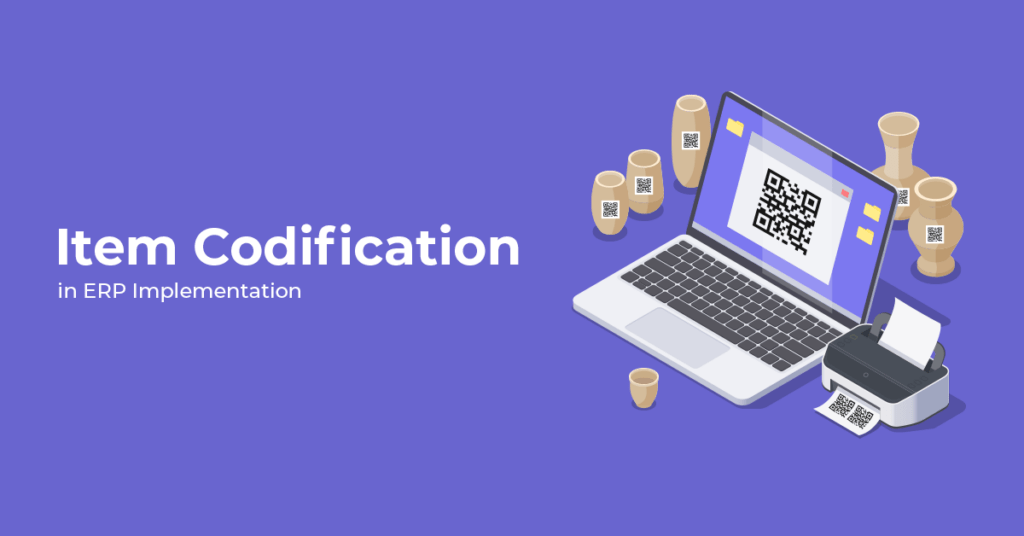
The process of item codification is a crucial step in ERP implementation, which ensures streamlined inventory management and transaction processes. This guide provides insights on assigning item codes, including when to use a unique code and when to use a common code for two items. The process can be complex, necessitating a comprehensive understanding of the specific industry. This guide aims to simplify this process with high-level guidelines.
Item codes are unique identifiers for each item in your ERP system. They play a pivotal role in various business areas such as inventory management, sales, and purchasing. An efficiently designed codification system allows for easy planning, tracking and analysis of different items within your organization.
A common mistake business owners make is assigning the same code to two similar items or creating separate codes for the same item with minor variations. This can lead to confusion. Consider a scenario where you’re purchasing an expensive pen for senior management, different from the typical pens used by the staff. Should this new pen have a separate item code? Ideally, it should be under the same item code, as it serves the same purpose, despite the price difference. However, if you’re purchasing an expensive pen to serve as a branded reminder, it should have a separate code as the cheaper pen can’t replace it.
“If an item is interchangeable in most use cases, it should have the same code.”
-Materials used in manufacturing come from various suppliers, however, one specific supplier is only approved for a specific market. If the approved supplier’s material is expensive and not economical to use for other markets, the material is one-way replaceable. But it does not make business sense to replace it. In this case, the material from the approved suppliers should have a separate code and all others should have a common code.
-Differentiation based on attributes: Assign separate codes to items with distinct attributes such as size, color, or material. For instance, shirts of different sizes (S, M, L) should have unique codes, even if they belong to the same category.
-Diverse pricing or cost structures: Assign separate codes to items within the same category or subcategory with different pricing or cost structures. Typically if the product has an identifiable attribute to indicate a price change it should have a separate code. For example, if a holiday special is announced with a special price of a FMCG product with highlighted packaging, it should be identified with a separate code. Even there would be a change in packing material artwork to support this. However, if the price of a medicine changes starting a specific lot/batch it should continue with the same code. Pharmaceutical ERP like Proteus Vision, supports lot-wise pricing to handle such business rules.
-Specification of the item: If the specification changes and is crucial in usage, the item should have a separate code.
In certain cases, two items can share the same code,
-Kit or assembly products: If two or more items are part of a kit or assembly and are always sold or used together, then the kit should have one code. This simplifies order processing and inventory tracking. Kit based sales feature is important for handling such complexities in an enterprise class ERP.
-Variants of the same item: If two or more items have minor variations but still belong to the same category and can be interchanged without affecting operations, a shared code is suitable. For instance, different sizes of screws or nuts within a specific category.
-Bulk items: If you deal with items sold in bulk, such as grains or liquids, it may be appropriate to assign the same code to these items. In this case, variations in package size can be managed through other attributes. Multi-unit sales purchases can be handled by applying a conversion factor.
Is it important to ensure that all stakeholders are clear about the guidelines. All should be well aware with adequate training about the process. A guideline should be created with following information.
-Must be centralised and unique code across multiple branches of the organizations.
-Choose a clear and consistent coding structure: This could include alphanumeric codes, such as a combination of letters and numbers.
-Use standardized formats: All item codes should follow the same format for consistency.
-Keep codes as short as possible: Aim for concise codes to minimize data entry errors and improve efficiency.
-Avoid using special characters: Special characters or symbols in item codes can cause issues in data storage and retrieval.
As it is a critical factor to ensure that item master is correctly managed, a person with proper domain understanding should review and approve. Sometimes there can be multiple level approval to ensure different aspects of the data in item master. A workflow based multiple level approval system would reduce manual errors, and increase efficiency. Proteus Vision Workflow is extensively used by our users to ensure quality and efficiency in this process.
-Regularly review and update item codes: As your product catalog evolves over time, new codes or modifications to existing ones may be required.
-Communicate coding conventions: Share your documented coding guidelines with your team to ensure consistent usage across the organization.
-Establish controls for code creation: Decide who has the authority to create or modify item codes to maintain data integrity and avoid duplication.
In an ERP implementation, codifying item codes is essential for efficient inventory management and precise data analysis. By adhering to the guidelines and best practices outlined in this guide, you can establish a robust codification system that promotes seamless transactions and effective decision-making.